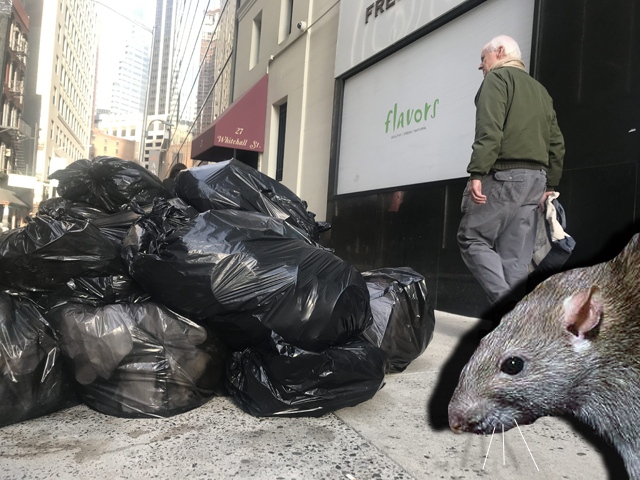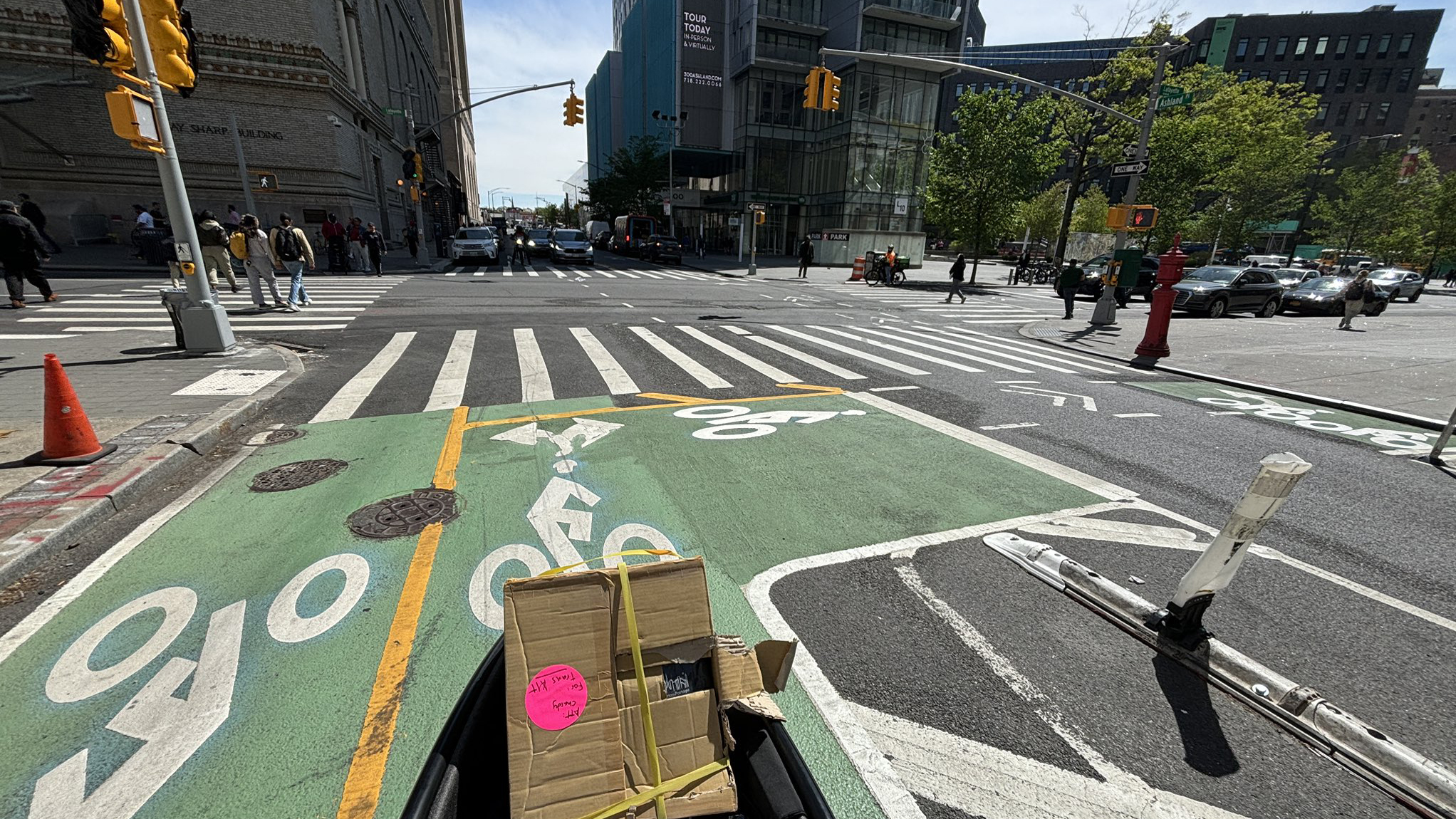OH, RATS! Experts Say Outdoor Dining is Not to Blame for the City’s Rodent Problem
12:01 AM EDT on August 8, 2022

This rat has met the enemy — and it is us.
They're just rat-cheting up the NIMBY fight.
Critics of outdoor dining are blaming the mostly beloved program for a rise in rats — a cause-and-effect theory now parroted across the media. But several rat experts interviewed by Streetsblog say that outdoor dining is merely a small factor in the recent rat spottings — the city's got much bigger fish to fry when it comes to mitigating its rodent infestation, like how the city disposes of its trash in thin, leaking, smelly garbage bags that line the sidewalks for blocks, creating a welcoming home with abundant food and shelter.
“Just how we get rid of garbage in general is one of the biggest issues,” said Larry Bernhardt, of Bensonhurst-based Top Notch Pest Control. "We’re basically just feeding them overnight. There should be metal garbage pails with tops that close."
It is unclear if the city’s rat population is truly on the rise: there has long been an estimated roughly 2-to-4 million rats in New York City, according to Dr. Michael Parsons, a rat expert and visiting scholar at Fordham University. But the real number is unknown, as some areas have way more than others, and most rats stay underground to avoid rude, unfriendly New Yorkers. Some estimate there could be as many as 32 million (!) rats in the city, Parsons said.
But one thing has changed this year: the number of complaints to 311 is on the rise.

So far this year, New Yorkers have registered 16,230 sightings of Rattus norvegicus and other pernicious rodent relatives — 2,451 more than reported during the same period last year, and 6,109 more than in 2019, when there were 10,121 complaints, according to city data.
But the vast majority of those complaints this year — 67 percent — were near residences, not, as opponents of outdoor dining would have the media believe, at restaurants. Hundreds of the other sightings this year have been reported at commercial buildings, construction sites, vacant lots, according to the city data, and apparently, in cars.
Residential rats are a problem the city has never put enough money or resources into mitigating, experts say.
Parsons, along with other scientists around the globe, analyzed 311 data at the start of the pandemic in 2020 and found that once the city had all but closed down, the rats ventured — though not far — from their typical feeding spots outside restaurants towards nearby residential areas, where people were cooking more at home and disposing of more smelly trash; and where they could find other food to subsist on, like dog poop (which rats love). Rats can travel for many miles, but they typically stay within about 300 feet of their nests, or social circle, experts say.
“(Rat sightings were) dramatically increasing in areas right around restaurants, going in nearby homes,” Parsons said. “Pet poop is a favorite of rats.”
But when restaurants reopened, the rodents scurried back.
“Now there’s rats in both places,” Parsons said.
The supposed increase, though, may simply be an issue of perception, he added. There are far more people outside since the onset of the pandemic — walking on open streets, or dining on an open restaurant street — and that means more rat sightings. But no one knows if the population has truly gone up.
“It’s a perfect storm of opportunity for growth, also people are out more, and more aware now,” he said.
Another expert, Benett Pearlman of Positive Pest, believes that outdoor dining structures represent a negligible part to the rat problem, since the way the restaurants dispose of their trash hasn’t changed, whether it's inside or outside.
“I wouldn't say [outdoor dining] has any bearing ... because ultimately outdoor dining ends up in bags, the same bags as pre-outdoor dining bags,” he said.
Or, hear me out, we throw it in containers and not on the sidewalk. https://t.co/pRW5OTB3Us
— Josh Gold (@JGoldny) July 28, 2022
Parsons agreed, adding that one of the biggest things the city can do is educate people to be tidier, clean up after themselves, and be more aware. He compared the city's rat population to oral hygiene, calling it urban hygiene.
“To me, outdoor dining has really been a blip on the radar," he said. "We’ve got a major source of decay already happening through garbage bags. The outdoor dining is just more like another sweet treat. If you got a cavity, it’s not the bad guy, it’s a reflection of our habits. The villains are not the rats, they're a reflection of us. I would rather focus on the big picture, on cleanliness.”
And Timothy Wong, the technology director at M&M Pest Control, said that while outdoor dining plays a role, the city cutting vital funding from sanitation and street-cleaning programs, and moving too slowly on containerizing trash are also too blame for the increase in rat sightings.
“Literally decreasing the budget to clean streets and decreasing pest control in the city, and outdoor dining being unregulated in terms of structures, all play a role in it," he said.
And another factor contributing to the city's rat population that hardly anyone talks about is fissures in the ground that can be caused by unregulated outdoor dining structures, Parsons added.
Rats, like the rest of us, don’t want to risk getting hit by a car, so they would rather cross a street by going under it than on it. So anything that causes a fissure on the sidewalk or in the street just creates more underground tunnels for rats to travel though, including some outdoor dining structures and another offender, trucks.
My favorite city rat sub-species: Rattus recklessaudacious. "Like, just goooo ahead & dig your burrow right here in the street curb for the whole world to see 🫤 . It's cool. We'll just sweep up.. chicken bones & all while waiting for the light to change!" 🐀🐀🐀🧹 pic.twitter.com/lsDe6TDDHh
— Bobby Corrigan (@rodentologist) July 27, 2022
The weight of massive big rigs parked on the sidewalk creates the same viable tunnels for those scared, shy rats to burrow through, allowing them to easily move from place to place, said Parsons, citing world-renowned rat expert Bobby Corrigan.
"The majority of rats are unseen, they don't like to take risks, and don't want to be around people," said Parsons. “Many times, trucks pull on the curb, literally pull up and shift weight on the curb. It seems innocuous, doesn't seem like a crime but it is sort of — once they do that, cracks are created way below. And then those cracks get larger in some areas, they shift with the earth, and so a rat just pops in and out...and makes its way from one side of the street to another street."
But a lot of where rats call home depends on the area, said Billy Swan of NYC Pest Control. In Park Slope, Swan's company deals mostly with rats in people's homes, thanks to construction and amateur yard work. Meanwhile, in low-income neighborhoods, he said, overcrowding and poor garbage disposal play a role.
“New construction is still booming, anytime you cut open the ground you usually open nests of rats, that would really be a big part of it, as far as sightings," said Swan. "Parts of the Bronx and Harlem, it’s overcrowding and massive amounts of garbage. Primarily in Park Slope, we’re dealing with new construction and beautification of the yards.”
Do “rat cities”exist below? Over time = Yup. 200 yrs cities cycle on: build,raze,rebuild : sewers, pipes, foundations, roads, utilities, etc = ‘abandoning’ millions old pipes in situ. Rats + old pipes = nests+highways. Rats LOVE abandoned infrastructure; homes for all.🐀🐀🐀🐀🧱 pic.twitter.com/B0uSciYW2P
— Bobby Corrigan (@rodentologist) July 9, 2022
But the biggest rat problem remains in low-income neighborhoods and public housing complexes, according to Council Member Sandy Nurse, who represents low-income communities of Cypress Hills, Brownsville, and East New York.
“The infestation issue happens for many reasons … some related to trash bags on our streets for several hours at night, some because we don't have aggressive rat-baiting strategy programs, in particular in hard-hit neighborhoods," she said. "People call us, NYCHA residents, because of rats in some of the units or across the development."
Still, naysayers persist — including those who have filed a lawsuit to end the 0utdoor dining program (though the city is currently seeking to modify it). The suit specifically sites "garbage and uncontrolled rodent populations, the blocking of sidewalks and roadways,” the suit says.
But Nurse doesn't see tearing down all the outdoor dining areas as a panacea.
"I do believe that those structures have lent themselves to rodents, but I don’t think if we got rid of those tomorrow, we’re going to solve the full rodent issue," she said. "Getting rid of permanent outdoor sheds is like the lowest-hanging fruit."
Julianne Cuba joined Streetsblog in February, 2019, after three years covering local news and politics at The Brooklyn Paper. There, she also covered the notoriously reckless private carting industry and hit-and-runs. A 2015 graduate of Stony Brook University’s School of Journalism Master’s Program, she lives in Brooklyn. Julianne is on Twitter at @julcuba. Email Julianne at julianne@streetsblog.org
Read More:
Stay in touch
Sign up for our free newsletter
More from Streetsblog New York City
DOT Aims to Build First Ave. Tunnel Bike Lane Before September’s UN General Assembly
DOT hopes to have the concrete-protect tunnel bike lane installed this summer, but its exact plans are still in development.
Waste Reforms Could Require Data on Crashes, Dangerous Driving
The proposal affects at least one trucking company with a deadly driving record.
When it Comes to Federal Infrastructure Grants, Size Does Matter
Cities and municipalities with larger budgets and staff are more likely to win competitive federal infrastructure grants, the Urban Institute has found.
Tuesday’s Headlines: Real Estate Greed Against Good Bike Lane Design Edition
A real estate developer's opposition to the Ashland Place protected bike lane yields some baffling bike lane markings. Plus more news.
City Considers Fixes for Another Ridiculously Slow Cross-Bronx Bus
Potential bus improvements are on the table for the Bronx's Tremont Avenue, but the Adams administration's failures on nearby Fordham Road loom large.




